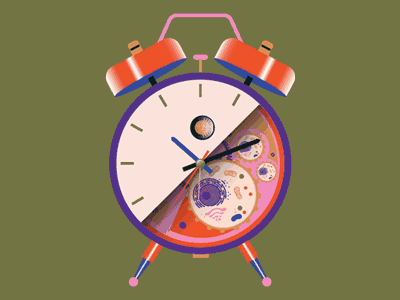
Black Tea and Intermittent Fasting for Women: Does It Break Your Fast?
That first cup of piping hot black tea in the morning is practically a sacred ritual for many of us. The rich, earthy aroma wafting through the kitche...

When it comes to fasting, timing is everything—literally. Aligning your eating patterns with your body’s circadian rhythm—your internal 24-hour clock—can make a significant difference in how your body processes food and maintains health. For women, syncing intermittent fasting with natural circadian cycles may lead to benefits like better hormonal balance, improved metabolism, and enhanced sleep quality.
Let’s explore why this approach works and how to make it part of your routine.

Your circadian rhythm is your body’s natural cycle that dictates when you wake up, eat, and sleep. It’s tied to the rise and fall of the sun, meaning your body expects activity (including eating) during the day and rest at night. Disrupting this rhythm by eating late can throw your system off balance, leading to issues like weight gain, poor sleep, and low energy.
Interesting Fact: Research from Nutrients shows that people who consume their calories earlier in the day have better metabolic health and are more successful at weight loss than those who eat later, even if both groups eat the same number of calories.
 for Women's Health A clock surrounded by healthy foods, representing circadian fasting and timed eating for optimal health.](/_astro/clock-and-food.Dbmu6WTN_1Mc6gu.jpg)
Fasting in sync with your circadian rhythm can lead to significant health improvements for women. Here’s why it’s so effective:
Hormones like insulin (which controls blood sugar) and cortisol (the stress hormone) are very sensitive to when you eat. Fasting at night and eating earlier in the day helps keep these hormones in balance, preventing mood swings and boosting energy.
Example: Many women experience the dreaded afternoon crash, especially juggling work, family, and daily stress. By eating your largest meals earlier in the day, you can stabilize your insulin levels, preventing that energy drop.
Your metabolism is naturally more active during the day, especially in the morning when insulin sensitivity peaks. By eating more during the day and fasting at night, your body can better manage blood sugar and burn calories efficiently.
Real-World Example: Instead of a heavy dinner, focus on lunch as your main meal. A protein-packed salad with grilled chicken or tofu, whole grains, and veggies will fuel your afternoon without overloading your system at night.
Eating late can interfere with melatonin production, the hormone responsible for sleep. Fasting in the evening allows your body to produce melatonin naturally, giving you deeper, more restorative sleep.
Example: Skip late-night snacking, and instead, enjoy a cup of herbal tea to relax before bed. You’ll notice fewer sleepless nights and improved rest.
Fasting encourages autophagy, where your body cleans out damaged cells and reduces inflammation. Syncing this with your natural circadian rhythm enhances the process, which is particularly beneficial for women dealing with inflammatory conditions like PCOS or chronic pain.
Fact: Studies have shown that women who follow time-restricted eating patterns aligned with their circadian rhythm experience up to a 30% improvement in insulin sensitivity and reduced markers of inflammation.
Here’s how to start syncing your intermittent fasting with your circadian rhythm:
Aim to have your first meal within a few hours of waking up. This aligns with your body’s natural cycle and gives you the energy you need throughout the day. Go for something filling yet balanced, like scrambled eggs with avocado or oatmeal with nuts and fruit.
Try to have your last meal of the day no later than 7 PM. This gives your body time to digest before sleep, allowing you to enter your fasting window and tap into overnight repair processes like autophagy.
Example: If you’re used to eating dinner late, try shifting to earlier meal times, like having a light dinner of grilled fish and vegetables or a hearty quinoa salad.
Keep your eating window regular, even on weekends. Consistency helps regulate your body’s clock, making it easier to stick to the routine and reap the benefits.

Here’s a 3-day meal plan for circadian fasting, where meals are consumed earlier in the day and fasting occurs overnight, typically following a window from 7 a.m. to 6 p.m. This allows the body to process food when it’s most efficient and supports hormonal balance and metabolism.
This meal plan follows a circadian fasting approach, where eating occurs during daylight hours, allowing the body to rest and digest before nighttime. By eating earlier in the day, you optimize insulin sensitivity and align with your body’s natural rhythm, leading to better energy, digestion, and sleep. Meals are balanced with proteins, healthy fats, and fiber-rich carbohydrates to keep you full and energized throughout the day.
A: Circadian fasting aligns eating with the body’s natural internal clock, or circadian rhythm. Meals are eaten during daylight hours, typically from morning to early evening, with a fasting window overnight. This approach supports better metabolism, hormone balance, and sleep quality by syncing food intake with your body’s optimal times for digestion and energy use.
A: Women benefit from circadian fasting by improving insulin sensitivity, balancing hormones like cortisol (stress hormone) and melatonin (sleep hormone), and reducing inflammation. Aligning food intake with daylight hours can help regulate energy levels, reduce mood swings, and improve overall metabolic health.
A: Yes! You can and should stay hydrated during your fasting window. Water, herbal teas, and black coffee are great options that won’t break your fast. Staying hydrated can also help manage hunger and improve mental clarity.
A: Eating late at night can interfere with your body’s melatonin production and insulin sensitivity, making it harder to sleep well and manage blood sugar. Circadian fasting encourages finishing meals earlier in the evening to allow your body time to rest and repair overnight.
A: Absolutely! Just be mindful of timing. It’s generally best to exercise during your eating window so that you can refuel afterward with a balanced meal. If you prefer to work out in the morning, consider breaking your fast shortly after exercising.
The information provided in this article is for educational purposes only and should not be considered medical advice. Always consult with a healthcare professional before beginning any fasting regimen, especially if you have underlying health conditions or are pregnant or breastfeeding. Circadian fasting may not be suitable for everyone, and individual results may vary based on health and lifestyle factors.
Fasting in sync with your circadian rhythm can provide significant benefits for women, from balancing hormones to improving sleep and boosting metabolism. By focusing on eating during the day and allowing your body to fast and repair at night, you’re working with your body’s natural processes. Start small, be consistent, and watch how much better you feel!

That first cup of piping hot black tea in the morning is practically a sacred ritual for many of us. The rich, earthy aroma wafting through the kitche...

Intermittent fasting (IF) and autophagy represent a burgeoning interest in nutritional science, particularly among women. IF is not merely a diet but ...

Intermittent fasting (IF) has gained popularity as a method of improving metabolic health and aiding in weight management. Among the most common metho...

The landscape of dietary practices is ever-evolving, with intermittent fasting (IF) emerging as a popular method attributed to numerous health benefit...

Have you ever considered the buzz around intermittent fasting (IF) and wondered how it fares for women with Type 1 Diabetes (T1D)? There's a lot to un...